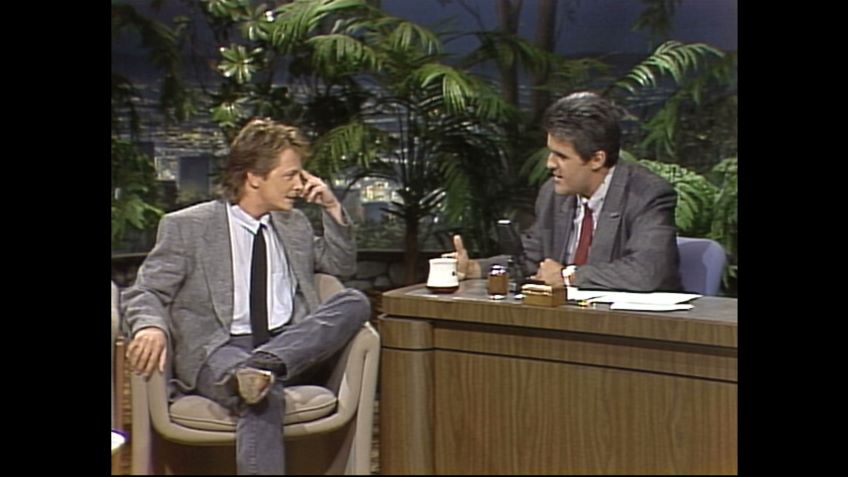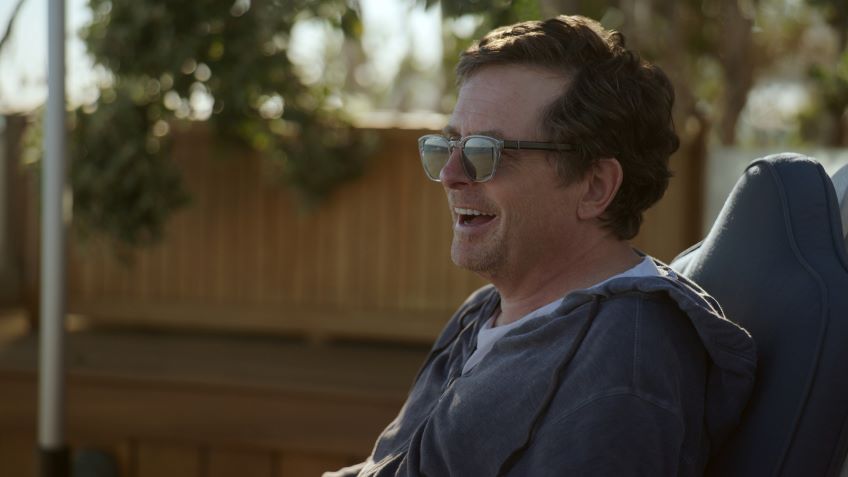Joyce Glasser reviews STILL: A Michael J Fox Movie (May 12, 2023) Cert 15, 95 mins. In select cinemas and streaming on Apple TV+
The title of this absorbing and inspirational documentary becomes clear soon enough. The former A-list actor might not have directed the documentary (Davis Guggenheim did) so it is only “A Michael J. Fox Movie” insofar as his presence is the film’s raison d’être and he is the star. “Still” refers to an impossible state for the now 61-year-old who has lived with involuntary movement since contracting early-on-set Parkinson’s Disease at 27. The irony is that as a boy and young man he didn’t know what it meant to be still.
The film is divided equally into a biopic of the actor’s engaging rags to riches story, including clips, and a long interview with the 61-year-old as he goes through and reflects on life with Parkinson’s. The reason the film is inspirational is that Fox continued to work for over two decades after going public with his diagnosis. Even after retiring from television and film for good because of slurred speech he did not stop working or retire from life. Fox embarked on a new career as a fundraiser and philanthropist with The Michael J Fox Foundation, and as an author, writing a series of books such as Lucky Man: A Memoir and Always Looking Up: The Adventures of an Incurable Optimist.

Much of this is made possible thanks to Fox’s marriage in 1988 to his Family Stars co-star Tracy Pollan. At the height of his fame, the handsome, if diminutive megastar, was a teen idol and had women throwing themselves at him. The story of their meeting on set and marriage showed Fox wanted an end to an unstable life. Fox is clearly enamoured and indebted to Pollan for her sacrifice (she seems to have given up her career), support, and for their four children.
Born in Edmonton, Canada Fox had to contend with a disciplinarian father whose peripatetic career in the military uprooted the family, making forming friendships difficult. His development was further affected when his younger sister grew taller than him leaving him open to bullying. Respite came in the form of a role in a Canadian sitcom, Leo & Me when he was 16. Fox’s height and baby face enabled him to play younger characters, but with the advantage of a more mature actor’s experience, discipline, and his ability to learn lines and work longer hours.
At 18 Fox dropped out of high school to pursue his career in Hollywood. Fox describes movingly how his father surprised him, not only by not objecting to his decision, but by accompanying his son to Los Angeles. Fox was working, but in small roles that did not pay the bills. His father (who lived to see his son become an international movie star but died just before his diagnosis) left him in L.A. to sink or swim.
Guggenheim devotes time to the fabulous story of Fox’s big break in landing the role of Alex Keaton in the new sitcom Family Ties against the background of Fox’s hunger, the squalor of his digs, his inability to pay the rent and the objections of Producer Brandon Tartikoff. Tartikoff argued that Fox was too short relative to the rest of the cast, adding ‘this is not the kind of face you’ll ever find on a lunchbox.’
But during the audition (this was live television) everything changed. People laughed. Within a short time the script was changed to give the son, Alex, the major role and Fox more bargaining and decision making power. Fox later tells a funny anecdote about a gift he gave Tartikoff after the show won several Emmys and Golden Globes.

So indispensable had Fox become to the ratings, that when Robert Zemeckis wanted Fox to replace Eric Stolz in his new film, Back to the Future, Tartikoff, did not tell the actor about the request. Eventually NBC acquiesced but Fox had to continue with his starring role in Family Ties in the day, while filming Back to the Future all night. In between he had three hours to sleep and learn his lines. Fox was so exhausted that he couldn’t imagine his performance was any good. Then the reviews appeared and his phone did not stop ringing.
Around the time of filming the romantic-comedy Doc Hollywood in 1991, Fox noticed a tremor in his little finger, which was diagnosed as early onset Parkinson’s. He went on to film The Frighteners in 1996 but returned to television after that with the successful series, Spin City for which he was awarded an Emmy (2000) and three Golden Globes. It was only in 1998 that he went public with the diagnosis.
The newsstands that were not very long ago lined with his handsome young face, flush with the success of Family Ties and Back to the Future, now featured the baby-faced actor for the shock value of the announcement. Although he defied his doctors, controlling the tics and trembling with the perfectly timed ingestion of pills, when his speech became slurred in 2020, he retired from acting for good.
What we notice from Fox’s appearance on all the talk shows is not only his charm, but his wit and natural humour. This is the humour that made him the star of Family Ties – his ability to enhance a character and script and ad lib. Guggenheim draws parallels, perhaps too many and too insistently, between Fox’s real life and the situations he is in in the sitcoms, but otherwise, this is a sensitively directed documentary, if less revealing than some might like about the pain of the disease and the toll on his marriage (despite calling himself an optimist, Fox turned to alcohol for a time to deal with the diagnosis).
At the end you realise this is A Michael J Fox Movie and a great story. Fox leaves us with a lot of nostalgia; a lot to smile about; a lot of “what ifs”, and a lot to think about: including how little we know about this dreadful disease.




